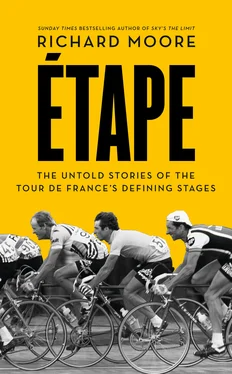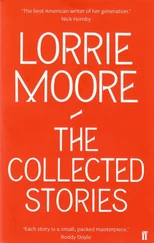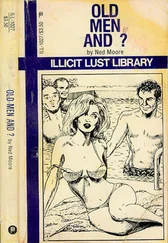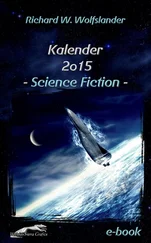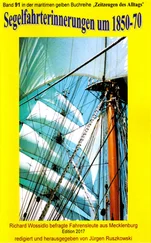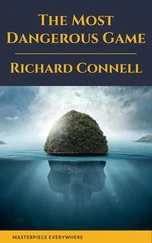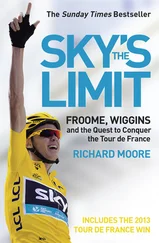It was the longest stage of the 1989 Tour: a grey, dreary slog south from Rennes, the capital of Brittany, down to Futuroscope, the futuristic but still unfinished theme park on the outskirts of Poitiers in western France. It was overcast and the stage, a bit like the theme park, promised little in the way of excitement. An unseasonably chilly wind blew directly into the faces of the riders, and they huddled together for shelter. The conditions did not suit a breakaway, the headwind favouring a large pack of riders over any small group. It was a day when there was strength in numbers.
After 31km, Søren Lilholt won an intermediate sprint. Sean Kelly won the second at 58km. John Talen took a third after 75km. Still the peloton was all together. In the lull that followed the third sprint, Pelier dropped back to the team car for his rain jacket and some bottles. And Mínguez joked, ‘Why don’t you attack?’
Pelier rode back up to the peloton, gave the bottles to his team-mates, the rain cape to Cubino, and made his way to the front. Then he proved to Mínguez that he did have balls. He attacked. ‘I thought there were others following me, but the peloton seemed surprised. So I used the surprise to go on my own. And I built a minute’s lead really quickly. But there were 180km left. On your own, that’s suicidal. You know that, because it’s such a long way, a breakaway is going to be destined for failure.’
Only one rider had ever stayed out in front on his own for longer in a Tour stage. Albert Bourlon, in 1947, was away for the best part of 253km after attacking near the start of the fourteenth stage in Carcassonne. Nobody else had gone close.
For Pelier, there were two choices. To sit up and go back to the peloton, tail between his legs, and face some gentle mocking from Mínguez, who would be unlikely to give him carte blanche to leave Cubino’s side again. Or carry on.
He carried on, bending his back and elbows to get low over his handlebars and cut into the wind.
There was something Pelier did not realise as he began his lonely effort. Waiting at the finish in Futuroscope were his parents. That was noteworthy because Pelier’s brother was severely handicapped and required twenty-four-hour care. Consequently, although his father had been able to attend a handful of events in his four and a half years as a professional, his mother had never seen him race. They hadn’t planned to travel the 700km from their home in eastern France. But Joël’s brother was in a residential centre for a few days. On the spur of the moment, they decided to drive the six hours from one side of the country to the other, to see their twenty-seven-year-old son in the Tour de France. They didn’t say anything. They wanted to surprise him.
* * *
‘I carried on and my lead kept increasing.’ When it went past nine and a half minutes, Pelier was yellow jersey on the road. But it kept growing, to ten, fifteen, eighteen minutes … ’It was twenty-five minutes at one point,’ Pelier says. ‘But even then, your mood is changing all the time. You believe, you don’t believe, you believe, you don’t believe. I tried to concentrate on managing my effort, and I did that quite well. I wasn’t a young rider; I was experienced.’
Pelier was a typical équipier , or domestique. A team man who, if he ever had individual goals, had learned that if he wanted a professional career he had to forget them. His career had been shaped by such hard lessons. In his first year, 1985, he was riding the Tour de France; they were in the Alps, on the 269km stretch between Morzine and Lans-en-Vercors, and he felt strong. So, in a moment of impulse, he attacked. ‘There were eight cols, and I attacked on the second one. What I didn’t know was that the leaders had decided to neutralise the race until the seventh climb.’
Pelier jumped away when he saw the Colombian, Luis Herrera, sprint for points for the King of the Mountains competition. He didn’t realise Herrera was not attacking: that he only wanted the points on offer at the top of the climb. Herrera sat up, but Pelier carried on. And Bernard Hinault, in the yellow jersey, set off after him. ‘Hinault caught me on the descent, and grabbed my jersey. He said, “What are you doing?” I said, “Don’t touch me!” He was angry and he told me, “You will never win a race!”
‘We had an argument, but then I understood. He was the patron , but afterwards it was exaggerated into a big story by the journalists, who saw Hinault go away on the descent to catch the little idiot who attacked.’
Three years later, as Pelier rode alone towards Futuroscope, Hinault set off in pursuit of him once again. When he caught him, he shouted – again. But Hinault was in a car this time, working for the Tour organisation in retirement, and his yells were of encouragement. He and Pelier had become friends at the 1986 world championships in Colorado, which Pelier rode for the French team, in support of Hinault. Now, as Pelier battled into the wind, Hinault repeatedly pulled alongside, winding down the window to speak to him. ‘He really supported me,’ Pelier says, ‘keeping me up to date with the time gaps, giving me constant encouragement. I think he was happy to see me have a go.’
Hinault knew this was a rare, perhaps unique, opportunity for a rider who had endured mainly misfortune in his career. A year after their run-in at the Tour, Pelier made the headlines again, and once more for the wrong reasons. At the finish of stage seventeen of the 1986 Tour, at the summit of the Col de Granon, he collapsed. It had been a particularly tough and high climb; indeed, the Granon is one of the highest roads in Europe, ascending to 2,413 metres, and steep too. But Pelier didn’t just collapse, he lost consciousness. An oxygen mask was strapped to his face as he was loaded into a helicopter and taken to hospital. Then he slipped into a seven-hour coma. He plays this down, dismissing it as simply the consequence of a ‘massive fringale’ – hunger knock. ‘I was hypoglycaemic. I had to stay in hospital overnight. I recovered quickly but not quick enough. You can’t have a day off at the Tour …’
Pelier’s career refused to run smoothly. Unusually for a French rider, he opted to join a Spanish team, BH, for the 1989 season. ‘I wanted an atmosphere that was warm and welcoming and I found that in Spain,’ he says. ‘I was lucky when I turned professional to ride for two years for Jean de Gribaldy.’ De Gribaldy, known as ‘The Viscount’, died, aged sixty-five, in a road accident on 2 January 1987. Pelier joined Cyrille Guimard’s Système U team the same year. ‘The Viscount is someone I think about often, even today. De Gribaldy loved cycling and loved his riders. And I needed that kind of atmosphere. With Guimard, I found a different atmosphere, one that didn’t work for me.
‘In 1988, I didn’t have a good season and it was difficult to find a team,’ Pelier says. ‘The Spanish put their trust in me and there was another Frenchman, Philippe Bouvatier, who encouraged me to join BH. The Spanish teams were full of grimpeurs [climbers], so they were always on the lookout for riders who could do everything, especially baroudeurs [fighters].’
His decision to cross the border was vindicated when, in April, Pelier crashed and fractured his sacrum, the large pelvic bone. It was another serious setback and yet it served to emphasise Mínguez’s qualities as a manager and his faith in Pelier. ‘I spent all of April, twenty-five days, lying in a plaster. The day of the accident, I thought my season was finished and I cried like a baby in the hospital in Pamplona. I was in a team that had recruited me specifically for the Tour de France. But my directeur sportif, Mínguez, he told me, as I lay in my hospital bed, to focus on getting better and that I could still be there at the Tour.’
Читать дальше
